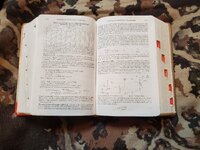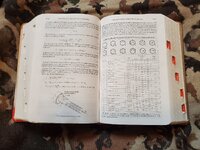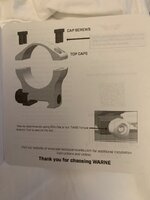Quoted for emphasis, and to ask for a citation?"Given the already high uncertainty in torque application for these small fasteners (often ±15-30% in real world conditions), the pitch-related variation in Loctite's effect on k-factor is probably not practically significant enough to warrant different compensation factors. The installation technique and joint friction variations would likely overwhelm any subtle differences from thread pitch."
Navigation
Install the app
How to install the app on iOS
Follow along with the video below to see how to install our site as a web app on your home screen.
Note: This feature may not be available in some browsers.
More options
Style variation
You are using an out of date browser. It may not display this or other websites correctly.
You should upgrade or use an alternative browser.
You should upgrade or use an alternative browser.
Does Loctite alter torque on scope rings
- Thread starter Lentuk
- Start date
This is your issue. Not overtorque at 15-18#, loctite or not.Locktite wasn’t the problem. It was either tightened down asymmetrically or there is a lack of concentricity/misalignment or size issue.
That is why it is good to check ring alignment with alignment bars before mounting the scope and if needed lap… or if way off, ditch the rings/base.
pacoalcracker
WKR
That last sentence of journeymans last post is the shit.....that is exactly how that scope got crushed. No two ways about it. Exactly how that happened isn't fully known yet, but I can assure it's probably not a Warne ring or Trijicon scope quality issue.
You are arguing exactly that.No one said Loctite is Oil. What was pointed out was, Dry screws and Wet screws have different torque ratings, due to the "Wet" has some lubrication qualities and he friction is reduced as a result. Meaning there is more force on the screw with the same torque.
Let's assume his torque wrench is 30% high.
Let's also assume loctite results in 30% additional torque (like a high quality lubricant might).
Warne says us 25 inch pounds, so with stacking those two large and unlikely errors, how far past spec did he get?
Let's assume Warne's spec only allows for 5% error.
So, if the math comes out that the improbablely high error amounts exceeds the impossibly precision of a 5% +/- torque spec, then sure, perhaps you have an argument.
So,
25x0.05+25=26.25
STOP, will the two errors compound to be greater than this?
Now,
15x0.3+15=19.5 in.lbs of torque from the wrench.
19.5x0.3+19.5=25.35 in.lbs worth of stretch in the fastener.
25.35 < 26.25.
Now, your argument was not the torque wrench was wrong. But I tried to help it by putting the wrench massively out of spec.
Here's some easy to read info on how quickly pitch can affect clamp force and bolt stretch. Pay attention to the finer pitches and how quickly clamp force comes up with little torque input change. Look at how small the wet vs dry coefficient is....and then note how substantial a clamp force increase occurs with such a subtle change.
None of this is the root cause of the failure, but with all of the quotes from sales literature getting tossed around and the fact that the internet is forever, there should be an understanding that pitch is critical in clamp force and friction.
And nobody has even mentioned the materials used. It's entirely possible to hit torque on a dry stainless fit without making contact.
This is a deep subject that has complicated answers.

None of this is the root cause of the failure, but with all of the quotes from sales literature getting tossed around and the fact that the internet is forever, there should be an understanding that pitch is critical in clamp force and friction.
And nobody has even mentioned the materials used. It's entirely possible to hit torque on a dry stainless fit without making contact.
This is a deep subject that has complicated answers.

journeyman713
WKR
Scope tubes are very thin wall, that's where the light weight comes from. so doing thing with finesse is important.I'm not trying to be argumentative, but how are you deducing 1 & 2 from 2 pictures?
The split ring clamp needs to have the Small gaps visibly equal, finger tight, before tightening systematically. The photo shows one end of the clamp bit into the scope, with what looks like a Large gap, even though the other side is not pictured, we can surmise it is fine, because there had to be no gap there at all.
In the scenario above, the round nature of the tube got elongated like an egg shape. then the clamp ring, that is made to be mated with something round, bit into it. Then it was really tightened down, leaving the witness marks in the photo.
Screws that are wet can apply 25-30% more force, than when dry, which multiplied the problem.
Mike Islander
WKR
Quoted for emphasis, and to ask for a citation?
Quoted because I pulled it from AI analysis. Feel free to put in the work to support your position if it's important enough to you.
The takeaway from this thread is that it's not Loctite that caused the failure.
Mike Islander
WKR
Here's some easy to read info on how quickly pitch can affect clamp force and bolt stretch. Pay attention to the finer pitches and how quickly clamp force comes up with little torque input change. Look at how small the wet vs dry coefficient is....and then note how substantial a clamp force increase occurs with such a subtle change.
None of this is the root cause of the failure, but with all of the quotes from sales literature getting tossed around and the fact that the internet is forever, there should be an understanding that pitch is critical in clamp force and friction.
And nobody has even mentioned the materials used. It's entirely possible to hit torque on a dry stainless fit without making contact.
This is a deep subject that has complicated answers.
View attachment 788359
Let's be clear about using wet or dry without context. As I already corrected you, wet does not necessarily equal "lubed". It depends on what the wet is. For example, assembly paste can increase K-factor up to 50%. That means you need 50% MORE torque to achieve correct preload.
You know...since the internet is forever. ;-)
TaperPin
WKR
- Joined
- Jul 12, 2023
- Messages
- 6,204
Finally, a chart with real numbers, dry and wet threads and clamping force! Good job tracking that down.Here's some easy to read info on how quickly pitch can affect clamp force and bolt stretch. Pay attention to the finer pitches and how quickly clamp force comes up with little torque input change. Look at how small the wet vs dry coefficient is....and then note how substantial a clamp force increase occurs with such a subtle change.
None of this is the root cause of the failure, but with all of the quotes from sales literature getting tossed around and the fact that the internet is forever, there should be an understanding that pitch is critical in clamp force and friction.
And nobody has even mentioned the materials used. It's entirely possible to hit torque on a dry stainless fit without making contact.
This is a deep subject that has complicated answers.
View attachment 788359
TaperPin
WKR
- Joined
- Jul 12, 2023
- Messages
- 6,204
I still find it strange that very very few applications anywhere outside of firearms specify dry threads. Very few.
Nice. I'll yeld that you probably understand the topic better than I do.You convinced me to pull out version 28 of machinery handbook, the reference standard.
Enjoy.
View attachment 788379View attachment 788380
Now, I still have a few questions.
Given that Warne specifies 25 in.lbs and recommends using thread locker:
-Did they just make negligently bad recommendations?
-Did they test using thread locker and determine that was the appropriate torque?
-Did they test dry and decid threadlocker was insignificant?
Obviously you cannot answer what they did, but how do we get from what they recommend to under torquing with a threadlocker like Warne recommends being the problem?
Also, can you tell me the difference in friction coefficient change between a true lubricant and thread locker? It cannot be assumed the two are the same, can it?
That Warne package literature is being taken entirely out of context. The pic that was posted was obviously of instructions for a scope BASE. 25# and Loctite into the receiver holes is fine and I think everyone will agree. That pic is not even relevant to this conversation.Nice. I'll yeld that you probably understand the topic better than I do.
Now, I still have a few questions.
Given that Warne specifies 25 in.lbs and recommends using thread locker:
-Did they just make negligently bad recommendations?
-Did they test using thread locker and determine that was the appropriate torque?
-Did they test dry and decid threadlocker was insignificant?
Obviously you cannot answer what they did, but how do we get from what they recommend to under torquing with a threadlocker like Warne recommends being the problem?
Also, can you tell me the difference in friction coefficient change between a true lubricant and thread locker? It cannot be assumed the two are the same, can it?
The debate is around torque on scope RINGS. Big difference.
Choupique
WKR
- Joined
- Oct 2, 2022
- Messages
- 1,070
Oof. This thread makes my head hurt.
Rotating equipment reliability guy checking in here. Loctite use was not the root cause of this failure. Impossible to say what was with the information given. Odds are it was an assembly mistake of some kind, but it certainly wasn't just loctite altering clamp force significantly.
Rotating equipment reliability guy checking in here. Loctite use was not the root cause of this failure. Impossible to say what was with the information given. Odds are it was an assembly mistake of some kind, but it certainly wasn't just loctite altering clamp force significantly.
pacoalcracker
WKR
The initial question was directed at who is at fault for this mishap, and the answer is pretty clear. The installer.
Warne used to recommend 25 in lbs for scope rings at least their mountain tech rings. Here is the install instructions from my set of mountain techs with a sticker over the 25in lbs that was recommended.That Warne package literature is being taken entirely out of context. The pic that was posted was obviously of instructions for a scope BASE. 25# and Loctite into the receiver holes is fine and I think everyone will agree. That pic is not even relevant to this conversation.
The debate is around torque on scope RINGS. Big difference.
Attachments
Easy man, not arguing—my position is that loctite doesnt matter enough to matter in this context, I just dont know a specific slam-dunk reference. I think you are saying something along the same lines as my position. I thought it was a good post or I wouldnt have emphasized it, just wondering where it came from. Is AI something like chatgpt, or is there a specific reference?Quoted because I pulled it from AI analysis. Feel free to put in the work to support your position if it's important enough to you.
The takeaway from this thread is that it's not Loctite that caused the failure.
Mike Islander
WKR
Easy man, not arguing—my position is that loctite doesnt matter enough to matter in this context, I just dont know a specific slam-dunk reference. I think you are saying something along the same lines as my position. I thought it was a good post or I wouldnt have emphasized it, just wondering where it came from. Is AI something like chatgpt, or is there a specific reference?
Sorry. I thought you were disagreeing. The quote is from an analysis by the Claude.ai AI program. But I've also done tons of my own research on this topic.
We are in violent agreement that it doesn't make a significant difference.
Got it. I had not noticed that.That Warne package literature is being taken entirely out of context. The pic that was posted was obviously of instructions for a scope BASE. 25# and Loctite into the receiver holes is fine and I think everyone will agree. That pic is not even relevant to this conversation.
The debate is around torque on scope RINGS. Big difference.
Looks like on another pair of rings (that I can find instructions for online) Warne ducks the question ands just says follow what the scope manufacturer says. Which in and of itself is good reason to never buy Warne in my opinion. How exactly can the scope manufacturer get to a clamp force with knowing the specs of the rings?
My lesson at the Ops expense is never by Warne products, and keep using NF rings with thread locker and 25 in.lbs of torque on the ring caps.
Similar threads
Featured Video
Latest Articles
- TT#64 Josh Boyd Elk Hunting Strategies for Every Season
- Aaron Davidson of Gunwerks
- TT#63 Dirk Durham’s Art of Elk Calling
- BIG Buck Stories with the Dirty Giants Podcast
- TT#62 Brian Barney Hunting Bulls without Calling
- Hoyt Alpha AX-2 SD Review
- Kuiu Kenai vs Outdoor Vitals Vario Hooded Jacket Review
- Hoyt RX-9 Ultra Review
- Hunting Vampire Bucks & Building an Optics Kit
- Darton Sequel ST2 35 Review




